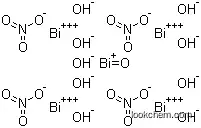-
Name
Bismuth subnitrate
- EINECS 215-136-8
- CAS No. 1304-85-4
- Density 4.928
- Solubility Soluble in dilute hydrochloric acid, nitric acid and dilute sulphuric acid; Insoluble in water, ethanol and glycerin
- Melting Point 260 °C
- Formula Bi5H9N4O22
- Boiling Point 83°C at 760 mmHg
- Molecular Weight 1461.99
- Flash Point
- Transport Information UN 1477 5.1/PG 2
- Appearance white powder
- Safety 17-26-36/37/39
- Risk Codes 8-36/37/38
-
Molecular Structure
-
Hazard Symbols
 O,
O, Xi
Xi
- Synonyms Bismuthhydroxide nitrate oxide (Bi5O(OH)9(NO3)4) (8CI);Basic bismuth nitrate;Bismuth oxynitrate;Bismuth subnitricum;Bismuthwhite;Bismuthyl nitrate;Blanc de fard;C.I. 77169;C.I. Pigment White 17;Cosmetic White;Magistery of bismuth;Novismuth;OrbeSeal;Roter;Snowcal 5SW;Vicalin;Vikaline;
- PSA 206.64000
- LogP 0.85230
Bismuth subnitrate Specification
The Bismuth subnitrate, with the CAS registry number 1304-85-4, is also known as Bismuth nitrate basic. It belongs to the product category of Inorganics. Its EINECS number is 233-792-3. This chemical's molecular formula is Bi5H9N4O22 and molecular weight is 1461.99. What's more, its systematic name is [(Dihydroxybismuthino)oxy](oxo)azane oxide - hydroxy(oxo)bismuthine (4:1). Its classification codes are: (1)Antacids; (2)Drug / Therapeutic Agent; (3)Human Data; (4)Pharmaceutic necessity. Antacid containing bismuth, sodium & magnesium carbonates, rutin, Khellin & Rhamnus bark powder. This chemical should be sealed and stored in a cool and dry place. Moreover, it should be ensured that the workshop is well ventilated or equipped with exhaust devices. It is used to prepared bismuth salt and bismuth salt.
Physical properties of Bismuth subnitrate are: (1)#H bond acceptors: 26; (2)#H bond donors: 9; (3)#Freely Rotating Bonds: 16; (4)Polar Surface Area: 419.34 Å2.
When you are using this chemical, please be cautious about it as the following:
This chemical is irritating to eyes, respiratory system and skin. In case of contact with eyes, you should rinse immediately with plenty of water and seek medical advice. When using it, you need wear suitable protective clothing, gloves and eye/face protection. When contact with combustible material, it may cause fire. You should keep it away from combustible material.
You can still convert the following datas into molecular structure:
(1)InChI: InChI=1S/Bi.NO3.O/c;2-1(3)4;/q+3;-1;-2
(2)InChIKey: InChIKey=VGCWJEOSAJKNRP-UHFFFAOYSA-N
(3)Smiles: [O-2].[Bi+3].[O-][N+](=O)[O-]
The toxicity data is as follows:
| Organism | Test Type | Route | Reported Dose (Normalized Dose) | Effect | Source |
|---|---|---|---|---|---|
| infant | LDLo | oral | 1gm/kg (1000mg/kg) | "Toxicology of Drugs and Chemicals," Deichmann, W.B., New York, Academic Press, Inc., 1969Vol. -, Pg. 134, 1969. | |
| infant | TDLo | oral | 259mg/kg (259mg/kg) | BLOOD: METHEMOGLOBINEMIA-CARBOXYHEMOGLOBIN | JAMA, Journal of the American Medical Association. Vol. 133, Pg. 1280, 1947. |
Related Products
- Bismuth
- Bismuth 2-ethylhexanoate
- Bismuth Acetate
- Bismuth arsphenamine sulfonate
- Bismuth bromide
- Bismuth citrate
- Bismuth dimethyl dithiocarbamate
- Bismuth hydroxide
- Bismuth nitrate
- Bismuth nitrate oxide
- 13048-84-5
- 13048-99-2
- 13049-01-9
- 13049-40-6
- 130497-33-5
- 13049-77-9
- 13050-47-0
- 13050-59-4
- 13051-01-9
- 130516-23-3
Hot Products
About|Contact|Cas|Product Name|Molecular|Country|Encyclopedia
Message|New Cas|MSDS|Service|Advertisement|CAS DataBase|Article Data|Manufacturers | Chemical Catalog
©2008 LookChem.com,License: ICP
NO.:Zhejiang16009103
complaints:service@lookchem.com Desktop View
